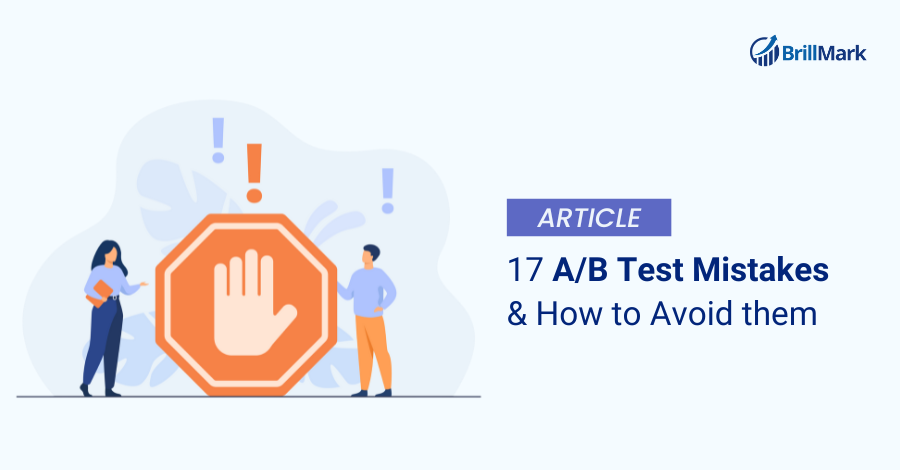Visualize this less than desirable scenario.
Having a consumer go into your business, shuffle around a few items, establish eye contact with you, to only walk out of the store.
A customer leaving a physical store prematurely is identical to having a website visitor leave in the middle of their experience on your website.
It’s kind of depressing, don’t you think?
Things could be much more disheartening if you own a website and notice that many people who visit your site leave abruptly and instead go to competitors’ websites.
So how can you increase the number of visitors to your website without them bouncing off your website to your competitor’s website?
One of the most prominent and long-term solutions is A/B testing.
Period.
A/B Testing is a unique marketing method for reducing bounce rates invalidating any degree of skepticism. It yields remarkable results, but only if properly executed.
Once you are on board with A/B testing, what if you poorly implement this solution?
Boom!
Truthfully, everything falls apart.
To avoid the wrong strategy, the best way is to reach out to experts like Brillmark, who specialize in A/B testing.
Did you know?
Even a one-second delay in page load time reduces page visits by 11% and conversions by 7%.
We understand that the journey to conversion rates that you can be proud of is not linear, having worked with hundreds of businesses over the previous decade.
We have aided countless clients in a variety of industries and regions. We have detected patterns in common mistakes based on our prior knowledge.
If you care about keeping visitors on your site, check out these A/B testing pitfalls to avoid and learn how Brillmark can help you to implement perfect A/B Test Development.
What is A/B Testing?
A/B testing compares different versions of a webpage, app, email, or other marketing methods to discover which version leads to the most conversions and is the most beneficial for your organization.
For instance, if you want to determine whether a new color combination of the call-to-action (CTA) button or the position of the CTA button (i.e., top or bottom of the site) would affect the click-through rate.
To determine whether this hypothesis would result in a change to the conversion funnel, you would construct an alternative version (Version B) to serve as the challenger to the original or existing design or control (i.e., Version A).
Then, the hypothesis will be implemented, and test observations will reveal which version draws more visitors and clicks.
Additionally known as split testing and bucket testing.
It took CXL 21 iterations to optimize their client’s website, yet the conversion rate increased from 12.1% to 79.3%.
A/B Testing mistakes & how to avoid them
Let’s review typical A/B testing blunders that waste your resources.
However, if you’ve already made a few errors, it won’t harm to examine the remedies available to you, so you can avoid repeating them in the future.
Instead of merely providing a list of these split-testing errors, we’ve categorized them according to when they occur:
Before, during, and after A/B testing.
Mistakes made before A/B Testing
Using an Invalid A/B Testing Hypothesis or No Hypothesis in Your Test

The effectiveness of your A/B testing and the viability of the results largely depends on how well you construct hypotheses.
In layman’s terms, an A/B test hypothesis relates to hypotheses on the causes of specific website outcomes, such as the bounce rate on your product page, high traffic with poor sales, etc.
If your hypothesis is incorrect, so will your A/B test results.
This is because modifications to your testing procedure are invalid if based on an incorrect hypothesis.
You can avoid this problem by researching correctly and developing an accurate hypothesis.
Develop a sound hypothesis by using data acquired using tools like Google Analytics, Google Search Console, heatmap recording, session recording, etc.
In addition, you may run surveys to learn what customers desire without disrupting their experience.
Did you know?
In 2009, Google experimented to see which shade of blue got the most clicks on search results.
This A/B test is infamously known as “Google’s 41 shades of blue” due to their decision to test 41 different hues. With a confidence level of 95%, the likelihood of false-positive results was a staggering 88%.
If they had examined only 10 hues, the likelihood of false positives would have decreased to 40% and just 9% if they had tested only three shades.
Developing Numerous Variations
As briefly stated above, several variations for website split testing do not guarantee more insightful data. They add to the confusion, slow down findings, and increase the likelihood of false positives.
And the domino effect continues, since the more variants you have, the more traffic you’ll need to succeed. To do this, you must run the test for an extended period.
The longer you run the test, the greater your likelihood of encountering cookie deletion.
It is quite likely that participants will remove their cookies after three to four weeks, the typical period of long-running experiments.
This will negatively affect your results since participants assigned to a particular variant may wind up in a different one.
A further disadvantage of several variants is the reduction in significance level. For example, the recognized level of significance is 0.05.
If you are evaluating ten variants, at least one of these variants will be statistically significant. As the number of situations rises, so does the relevance of opportunity, leading to a false positive.
Putting anything live before testing it!

You may be eager to launch a brand-new page or website design without testing it.
Hold up!
Perform a simple test to determine its functionality. You should not implement a significant change without first gathering data.
Otherwise, you risk losing revenue and conversions.
Occasionally, this new modification might result in a significant performance decline. So first, do a brief test.
Copying Ideas for Testing from Case Studies

Other case studies’ A/B testing procedures should not be replicated.
Your business is unique; therefore, imitation will not yield the most satisfactory outcomes.
Rather than copying & pasting from the case studies or based on things that work for your competitors, you should complete a thorough analysis.
Analyze the case studies and draw inspiration and ideas from them to design an outstanding A/B testing strategy for YOUR organization.
Analyze case studies carefully to see which tactics others adopted and why so that you may adapt them to your firm.
Not verifying whether the A/B Testing tool functions properly

Always remember No testing tool is 100% accurate.
Even if it’s the industry standard or recommended tool, always verify the tool before doing the final implementation of the test.
As a beginner, you should do an A/A test to determine the precision of your tool.
How?
Simply conduct an experiment in which you distribute traffic evenly between two pages.
(Make sure it’s a page where visitors may convert so you can measure a specific outcome.)
Why?
Since both audiences are exposed to the same page, the conversion rates should be similar on both sides of the test, correct?
Occasionally, they aren’t, which suggests that your tool may be improperly configured.
Before launching any campaigns, you should verify your testing tool.
Not establishing an objective for the test in advance
 Once you have a hypothesis, you may connect it with a specific outcome you wish to attain.
Once you have a hypothesis, you may connect it with a specific outcome you wish to attain.
Occasionally, individuals simply run a campaign and observe the results.
Still, you will generate more leads, conversions, and sales if you have a clear understanding of which part you wish to see an increase in.
This also prevents you from observing a decline in a crucial metric but deeming the test a success since it “received more shares.”
Did you know?
TruckersReport had to do six rounds of A/B testing to increase landing page conversions by 79.3%.
Mistakes made during A/B Testing
Not running A/B testing long enough to obtain precise findings.
There are three crucial considerations to make if you wish to obtain reliable test results:
Significance in Statistics, Sales Cycle, and Sample Size.
So, let’s dissect it.
The majority of individuals terminate tests when their testing tool indicates that one result is superior to the other AND the result is statistically significant, i.e., if the test continues to perform in this manner, this is the clear winner.
The truth is, you can reach “stat sig” quite quickly with a tiny quantity of traffic. All conversions occur on one page and none on the other page at random.
However, it won’t always be this way. It’s possible that the test went live on payday, and you made many sales that day.
Sales and traffic might change depending on the day of the week or the month. For this reason, we must consider the sales cycle.
For a more accurate depiction of how your test is performing, you should preferably run it for two to four weeks.
Finally, the sample size is determined.
If you run your test for a month, you will likely receive sufficient traffic to obtain reliable findings.
Too little, and the test won’t be able to assure that it will function as intended.
Thus, as a general rule,
- Strive for a 95% confidence level.
- Duration: one month
- Determine the sample size you’ll need in advance, and don’t stop the test until you’ve reached it, OR obtain a result that confirms beyond a reasonable doubt that you have a winner.
Too Many Element Tests Concurrently

People sometimes believe it is prudent to test versions of several elements during A/B testing in order to save time and money.
Let us just state the obvious: IT IS NOT.
We will explain why this is so.
If you test numerous items simultaneously, you must generate multiple variants (an error we will discuss).
However, this is not the worst part.
You cannot determine the root element for your findings. What variant of what constituent enhanced the conversion rate suddenly?
It completely negates the objective of A/B split testing, and you will have to start from scratch.
How can we overcome this A/B testing error?
Multivariate Testing.
During multivariate testing, you can adjust numerous variables and track the performance of each.
Thus, you can determine which factors had the most influence during testing.
Testing with the wrong Traffic
In addition to ensuring that the time is correct, the success of your A/B testing plan requires the proper traffic.
There is traffic that is qualified, interested, and willing to purchase your products, and there is traffic that will not convert.
How to avoid making this A/B testing error:
Determine the appropriate traffic and concentrate your A/B experiments on it.
For instance, you may filter the data by visitor type to see whether your modifications are beneficial to your target audience.
Not monitoring user comments

Let’s assume the test is receiving clicks and the traffic is being disseminated, so it *appears* to be functioning, but you begin receiving complaints that users are unable to complete the sales form.
(Or, even better, you get an automatic warning that a guardrail measure has fallen well below permissible limits.)
Then you should immediately suspect that anything is broken.
It is not always the case.
There’s a chance that you’re receiving clicks from an audience that isn’t interested in your offer, but it’s worth examining that form just in case.
If something is broken, correct it and restart.
Did you know?
60% of organizations find A/B testing highly valuable for optimizing conversion rates.
Changing test parameters mid-test
Changing test settings amid an A/B test, such as traffic allocation, is a prescription for failure and a huge NO.
For instance, if a user enters Variation A, they should view this variation for the test duration.
Changing settings in the middle of the test will result in this consumer seeing Variation B. Since this client participated in both tests, the integrity of your data has been compromised due to this A/B testing error.
Also, to give all of your variants a fair shot, you must evenly disperse the traffic to obtain the most realistic results. Anything other than this will negatively impact your findings.
For example, suppose you allocate 80 percent of the traffic to Control and 20 percent to variation.
This ratio should ideally remain constant. However, if you adjust it to 50-50, all users will be randomized.
Additionally, you should not alter the variants themselves.
Do not make modifications to the already-running variants, making it hard to determine the reason for the outcomes.
If the test is functional, let it run and let the data determine what is effective.
Mistakes made after the A/B Testing is complete
Less Than Meticulous Measurement of Results

It is exceptional if you did not experience any of the aforementioned A/B testing issues and conducted successful tests.
But don’t rejoice just yet. Several errors are made when measuring and assessing the A/B testing data.
Once you have credible data, you must evaluate it properly to derive maximum advantages from A/B testing.
Be meticulous!
Tools such as Google Analytics are helpful in this regard. To determine whether your A/B testing approach was successful, you may observe changes in conversion rate, bounce rate, CTA clicks, etc.
If your tool displays averages, you cannot be too confident in the statistics, as averages are frequently inaccurate.
Obtain a tool that facilitates data transmission to Google Analytics. The Events and Bespoke Dimensions capabilities may be used to segment data and generate custom reports for in-depth study.
Not appropriately reading the findings
What do your results actually reveal? Incorrectly reading them may easily make a potential winner appear to be a dismal failure.
Immerse yourself in your metrics.
Look at whatever qualitative data you have.
What was effective and what wasn’t? Why did that happen?
The more your comprehension of your outcomes, the better.
93% of US companies do A/B testing on their email marketing campaigns.
Not Considering Minor Successes
If you believe that a 2% or 5% increase in conversion rate is trivial, consider the following: These results are derived from a single test.
Suppose your conversion rate increased by 5 percent, but the cumulative yearly conversion lift would be substantially more.
These seemingly tiny increases are the reality of A/B testing, which may translate into millions of dollars in sales.
Consequently, neglecting them is one of the most significant A/B testing errors you can make.
Significant increases, such as 50%, are only conceivable if a poorly designed website undergoes frequent radical testing or is redesigned.
Lacking Knowledge of Type I and Type II Errors
Type I and Type II errors insidiously seep into your A/B testing, despite the fact that you may believe you’ve done everything correctly.
Therefore, you must be vigilant to identify them early in the process before they bias your findings.
This issue is also referred to as Alpha () error and false positives. The tests appear to function in this mistake, and the modifications produce results.
Unfortunately, these boosts are ephemeral and will disappear once the winning variety is launched globally for an extended duration.
For instance, you may test certain inconsequential factors that may provide favorable results in the short term but will not yield actual effects.
False positive and false negative errors in surveying
The error of type II, also known as Beta () errors or false negatives, occurs when a test seems inconclusive or ineffective, with the null hypothesis appearing to be true.
In this context, the null hypothesis is a theory you are attempting to refute, yet it looks true in Type II error.
For instance, you may assume that some tested items did not yield favorable results when, in fact, they did.
In actuality, the variation affects the desired outcome, yet the data support the null hypothesis.
You accept (incorrectly) the null hypothesis and reject your hypothesis and variation.
Testing Incredibly minor Elements
Changing a minor aspect such as the CTA button’s color may not provide a substantial impact for small businesses or startups, which wastes time and money.
Therefore, you must determine which factors are vital and will yield substantial effects.
You may find tremendous success by incorporating additional high-quality content and media as an alternative to modifying the typefaces on your product page.
In conclusion, pick your test items with care. Here are some recommendations:
- Make your website’s headline engaging and representative of your brand.
- Make your pricing transparent and appropriate for your target market.
- Call-to-action; differentiate it from other UI components.
- Product Description: Describe the product’s characteristics to facilitate client decision-making.
- Media include photographs, videos, etc.
Did you know?
According to Convert, 9 out of 10 tests are usually failures.
What does it mean? Does it mean A/B testing is a waste of time?
Absolutely Not!
A/B testing figures out what is valuable and helpful for your website. Each test will give you a new answer. It just means that if you don’t get your expected answer, don’t give up.
That implies you must conduct ten tests to determine the winner. It requires effort but is always worthwhile, so do not give up after a single campaign!
Not sufficient testing!

Tests are time-consuming, and we can only run so many at once.
What, then, can we do?
Simply decrease the intervals between tests!
Execute a test, evaluate its outcome, and then iterate or conduct an alternative test. (Ideally, they should be lined up and ready to go.)
This will result in a significantly greater return on your time commitment.
Conclusion
We hope you now understand the dos and don’ts of A/B testing and the pitfalls to avoid.
Don’t forget that everything begins and finishes with the consumer.
Before building your hypothesis on assumptions, ensure that you have listened to consumer feedback and analyzed what modifications would improve their experience and, consequently, your conversions.
Utilize this approach for future campaigns to circumvent these concerns.
A/B testing is one of the most acceptable ways to increase a website’s conversion rate. It aids in preventing several overlooked errors that may negatively impact your business.
This enhances the site and, thus, the user experience.
The first stage is to develop a solid strategy for the project so that you have time to make adjustments.
Since the preceding material should have provided you with some ideas, the next step is implementing them through testing.
Initially, you may be able to manage testing with your in-house team, but as your website evolves, it will necessitate increasingly complicated tests.
Dynamic A/B testing needs the support of competent engineers, UX designers, Q&A specialists, and others; thus, outsourcing the A/B tests is the ideal course of action.
Maintaining consistent traffic requires handling this while avoiding A/B testing problems.
Follow the outlined steps to learn how to convert traffic into consumers and enhance your conversion funnel.
If you do not have a team to assist you with A/B testing, construction, and setup, contact Brillmark for assistance.
For over a decade, we have managed tests for clients that value expert testing resources.
Contact us now for more information.
Always be testing!











